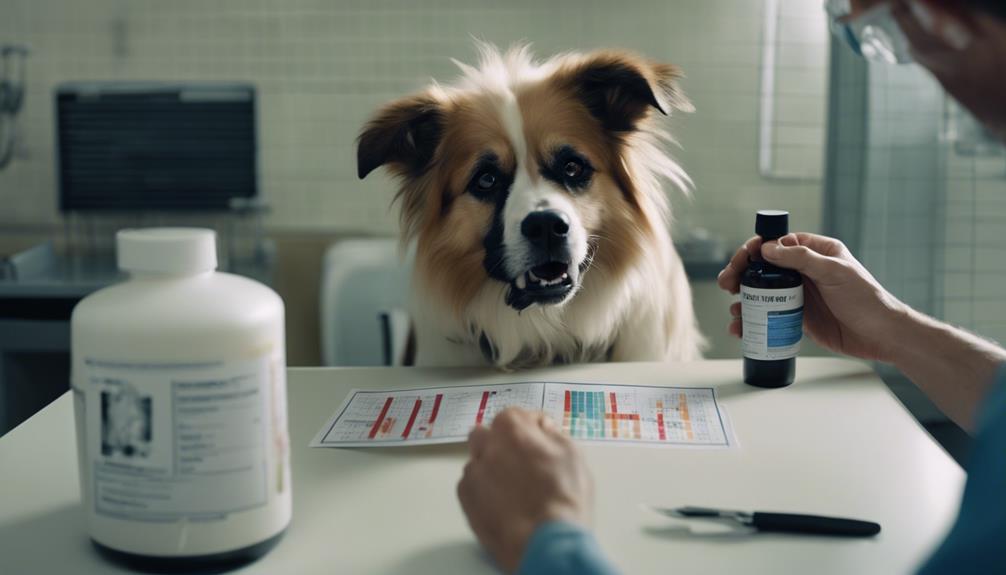Exploring the realm of canine culinary options often leads pet owners to question the compatibility of whipped cream with their furry companions' diets. The considerations surrounding this seemingly harmless treat extend beyond mere indulgence, delving into crucial aspects of canine health and nutrition.
As we navigate the complexities of whipped cream consumption by dogs, a deeper understanding of its potential implications emerges, offering insights that may reshape our approach to pampering our pets. Before you decide to treat your pooch to a puppuccino, there are essential aspects to consider that could impact your pet's well-being in unexpected ways.
Key Takeaways
- Whipped cream is generally safe for dogs, but monitor for any adverse reactions.
- Offer whipped cream in moderation to avoid weight gain and digestive issues.
- Avoid sugar-free whipped cream with xylitol, a harmful sugar substitute for dogs.
- Consider healthier treat alternatives like fresh fruits and vegetables over whipped cream.
Whipped Cream Ingredients and Composition
Whipped cream is a delectable topping created from a blend of cream, sugar, vanilla, and various flavorings. This rich and creamy indulgence adds a luxurious touch to desserts, beverages, and more. The cream provides the base, offering a smooth texture, while sugar contributes sweetness, and vanilla enhances the flavor profile. Additional flavorings such as cocoa, almond extract, or fruit extracts can further elevate the taste.
When considering feeding whipped cream to dogs, it's crucial to be mindful of these ingredients. While dogs can generally enjoy whipped cream in moderation due to its non-toxic nature, it's essential to monitor their intake and ensure that the topping does not contain harmful additives like xylitol.
Store-Bought Whipped Cream Varieties
When considering store-bought whipped cream varieties, it is important to be aware of the range of options available and their specific ingredients. Traditional whipped cream is made from cream, sugar, and vanilla, providing a rich and creamy texture.
However, store-bought options like Cool Whip may contain additional preservatives and additives for enhanced shelf life. It's crucial to read the labels carefully to understand the composition of the whipped cream and identify any ingredients that may not be suitable for your dog.
While traditional whipped cream is generally safe for dogs in moderation, being mindful of the specific store-bought variety you choose can help ensure your furry friend's well-being.
Non-Dairy Whipped Topping Alternatives

Non-dairy whipped topping alternatives offer a suitable option for dogs with dietary restrictions or sensitivities to dairy products. These alternatives, such as coconut or almond whipped toppings, provide a lactose-free and vegan-friendly option for pet owners looking to treat their dogs without the potential digestive issues that dairy products may cause.
These non-dairy options can be a safer choice for dogs prone to gastrointestinal upset or allergies. When considering whipped toppings for your furry friend, it's essential to check the ingredients to ensure they are free from harmful additives.
Safety of Whipped Cream for Dogs
The safety of incorporating whipped cream into a dog's diet should be approached with caution and consideration of potential risks.
While whipped cream is generally safe for dogs as it lacks toxic ingredients, it can pose certain health concerns. Some dogs may experience issues like vomiting or diarrhea, especially with excessive consumption due to its high-calorie content.
It is crucial to monitor your dog's reaction closely when introducing whipped cream as an occasional treat. Starting with a small amount and transitioning to healthier alternatives like fresh fruits and vegetables is recommended.
Additionally, avoiding sugar-free whipped cream containing xylitol is essential to prevent toxicity. If any adverse symptoms occur, contacting a vet promptly is advised.
Risks of Feeding Whipped Cream

Feeding whipped cream to dogs poses potential risks due to its high-calorie content and the possibility of causing gastrointestinal issues such as vomiting or diarrhea. While whipped cream itself is not toxic to dogs, excessive consumption can lead to weight gain and other health problems. It is crucial to offer whipped cream in moderation and monitor your dog's response closely.
Additionally, be cautious with store-bought options that may contain preservatives, and avoid sugar-free varieties with xylitol, a harmful sugar substitute. Transitioning to healthier alternatives like fresh fruits and vegetables is recommended to prevent overindulgence in high-calorie treats.
If any adverse reactions occur, contacting a vet promptly is advised to address any potential concerns.
Importance of Moderation
Understanding the significance of moderate consumption is paramount when considering offering whipped cream as an occasional treat for dogs. Moderation ensures that your furry companion can enjoy the treat without facing any adverse effects.
To emphasize the importance of moderation when feeding whipped cream to dogs, consider the following:
- Controlled Portions: Offering small amounts of whipped cream helps prevent overconsumption and potential digestive issues.
- Calorie Awareness: Being mindful of the high-calorie content in whipped cream can aid in managing your dog's weight and overall health.
- Balanced Treat Options: Incorporating a variety of healthier treat alternatives alongside whipped cream promotes a balanced diet for your dog.
Observing Your Dog's Reaction
When introducing whipped cream to your dog, closely monitor their response to ensure their well-being and tolerance of this treat. Observe your dog for any signs of digestive issues such as vomiting or diarrhea after consuming whipped cream.
Pay attention to their behavior, energy levels, and any changes in appetite. Some dogs may have sensitivities to dairy or certain ingredients in the whipped cream, so it's crucial to watch for any adverse reactions.
If your dog shows any negative effects, such as itching, licking, or discomfort, discontinue feeding them whipped cream immediately. By carefully observing your dog's reaction, you can determine if whipped cream is a suitable and safe treat for them.
Transitioning to Healthier Options
After observing your dog's response to whipped cream, it is prudent to consider incorporating healthier alternatives into their diet. Making mindful choices can contribute to your dog's overall well-being.
Here are some options to transition to:
- Fresh Fruits: Introduce fruits like apples, bananas, or berries as a nutritious treat.
- Vegetable Snacks: Consider offering vegetables such as carrots, green beans, or sweet potatoes for added vitamins and fiber.
- Plain Yogurt: Opt for plain, unsweetened yogurt as a probiotic-rich alternative to whipped cream.
Caution With Desserts and Treats

Exercise caution when offering desserts and treats containing whipped cream to your dog to prevent potential health issues. While whipped cream itself is not toxic to dogs, it can lead to gastrointestinal problems such as vomiting or diarrhea, especially in those with sensitive stomachs. Additionally, the high-calorie content in whipped cream can contribute to weight gain if consumed excessively.
It is essential to monitor your dog's reaction when introducing whipped cream as an occasional treat. Consider starting with a small amount and gradually transitioning to healthier alternatives like fresh fruits and vegetables. By being mindful of portion sizes and frequency, you can minimize the risks associated with indulging your dog in whipped cream and similar treats.
Sugar-Free Whipped Cream Warning
While whipped cream itself is generally safe for dogs in moderation, a crucial warning pertains to the potential dangers of sugar-free varieties containing xylitol, a harmful sugar substitute. When considering offering sugar-free whipped cream to your furry friend, keep the following points in mind:
- Xylitol Toxicity: Even small amounts of xylitol can be toxic to dogs, leading to symptoms like vomiting, lethargy, and in severe cases, liver failure.
- Hidden Dangers: Sugar-free products may not always clearly indicate the presence of xylitol, so always check the ingredients list before sharing whipped cream with your dog.
- Vet Consultation: If you suspect your dog has ingested xylitol-containing whipped cream, seek immediate veterinary assistance to prevent potential complications.
Veterinary Consultation for Poisoning

In cases of potential poisoning from ingesting harmful substances like xylitol-containing whipped cream, prompt veterinary consultation is imperative to safeguard your dog's health and well-being. If your dog shows symptoms such as vomiting, lethargy, weakness, or seizures after consuming whipped cream with xylitol, seek immediate veterinary attention.
Time is of the essence in addressing poisoning incidents to prevent further complications. Inform the veterinarian about the quantity ingested and the ingredients present in the whipped cream. Treatment may involve inducing vomiting, administering activated charcoal, providing supportive care, or other interventions based on the severity of the poisoning.
Always keep the contact information of a local emergency veterinary service readily available for quick action in such situations.
Starbucks Puppuccinos and Considerations
After addressing potential poisoning concerns from xylitol-containing whipped cream, it is important to consider the implications of high-fat treats like Starbucks Puppuccinos on dogs' health.
Starbucks Puppuccinos and Considerations:
- High Fat Content:
- Puppuccinos are high in fat, which can lead to obesity and pancreatitis if consumed excessively.
- Moderation is Key:
- Offering Puppuccinos as an occasional treat in small quantities is advisable to avoid health issues.
- Healthier Alternatives:
- Consider substituting Puppuccinos with healthier options like plain whipped cream, fruits, or vegetables to maintain a balanced diet for your dog.
Healthier Treat Alternatives for Dogs

Consider incorporating nutrient-rich options like fresh fruits and vegetables as healthier treat alternatives for dogs. These alternatives provide essential vitamins, minerals, and fiber, promoting overall well-being.
Fruits such as apples (without seeds), bananas, and blueberries can make tasty and healthy snacks for your furry companion. Vegetables like carrots, green beans, and sweet potatoes are also excellent choices that dogs often enjoy.
Not only do these options offer a crunchy texture that can help with dental health, but they are also lower in calories compared to many commercial treats. When selecting treats for your dog, prioritize natural, whole foods to support their health and provide a delicious variety in their diet.
Conclusion
In conclusion, the decision to offer whipped cream to dogs requires careful consideration of its ingredients and potential risks. While some dogs may tolerate whipped cream in moderation, others may experience digestive issues or adverse reactions.
It is important for pet owners to prioritize their furry companions' well-being by exploring safer alternatives and consulting with a veterinarian if necessary. Maintaining a balanced and diverse diet for dogs is essential for their overall health and happiness.




